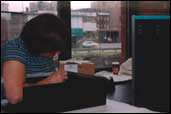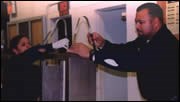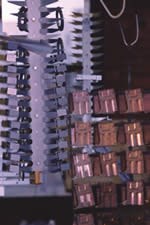C.I.L.—Where Tradition Meets Today
Even though the company has only been in business 10 years, it has more than 125 years of experience in the finishing industry...
New England is home to many finishing shops; most of which have deep-rooted histories. C.I.L, Inc., in Lawrence, MA, however, is a relatively new company, yet it still boasts a strong history. Its core group of managers has more than 125 years of plating experience. All of this experience, garnered from other finishing companies in New England, merged into one when C.I.L. was established. This provided the company with know-how and connections throughout New England.
The group set up shop in a refurbished mill building that had been used by the textile industry. (It was a department store after that.) Located near the Merrimack River, the 70,000-sq-ft, red-brick structure provided ample room for the ambitious company.
Featured Content
Chromic acid, sulfuric acid, hardcoat and teflon-impregnated hardcoat anodizing were the first finishes offered by C.I.L. Now the company also offers chromate conversion coatings; passivation; cadmium , electroless nickel, bright nickel, sulfamate nickel, gold, silver, tin, tin-lead, copper zinc-nickel and zinc plating; dry film lubricants and painting and powder coating to military, federal and aerospace specifications. Even with all of these finishes, anodizing is still the company's most popular finish.
“For the past several years, we have been looking to take that giant leap, and do it in a very difficult economy. We knew that to grow the business to the next level was a major process, but we were dedicated. We have met the challenge of surviving while evolving into what we want to be,” noted Vice President Marko Duffy.
How has the company met the challenge? One explanation is the company’s involvement in associations, particularly the Boston Tooling and Machining Association, which represents much of C.I.L.’s customer base. “We think these shops are some of the best, brightest and most forward looking machine shops out there. That is why we stay connected to them through the associations,” Mr. Duffy commented. If a customer calls the company needing a particular finish that C.I.L. doesn’t offer, Mr. Duffy and the management team consider the costs and return on investment for adding that finish. The company wants to concentrate on its core customers, providing as much service to these customers as possible. “This is how we have grown,” stated Mr. Duffy. “We may have the same core customers as we had several years ago, but we are doing more finishing for them.” C.I.L. has achieved NADCAP approval as well as approval from Boeing and several other aerospace firms in its quest to be the only finisher its customers need.
Hardcoat Anodizing
Anodizing is critical to the aerospace industry, a prime customer base for C.I.L. The aerospace industry uses aluminum extensively because it is light weight and ductile. The aerospace industry and the military use mainly hardcoat anodizing because it renders the aluminum extremely hard (60-70 Rockwell C), heat resistant, provides corrosion resistance of 336+ hours per ASTM B117, and it provides electrical insulation of 800v/mil thickness. Hardcoat anodizing works best with 5000, 6000 and 7000 series aluminum alloys.
Alloys that have a high copper content should not be hardcoat anodized. For example, higher copper alloys such as 2024 and 2011 are easy to machine because of the copper; however the copper portion of the surface metal does not anodize during sulfuric acid anodizing, making it difficult to pass the salt spray tests. It can be hardcoat anodized, but the film is softer because more voltage is required to maintain current density. If more voltage is used, more heat is generated and there is a potential for burning. Every aluminum alloy anodizes differently, because alloy metals change the conductivity of the part, forming aluminum oxide.
The A Line at C.I.L. is a hoist line with eight-foot tanks. The processes on this line include conventional sulfuric acid anodizing and hardcoating with a Clariant additive, Anodal EE. According to Clariant Corporation, Pigments, Dist. by Reliant Aluminum Products representative, Christian Ebbrecht, the additive allows C.I.L. to anodize parts using a higher temperature and higher current density than used in conventional low-temperature hardcoat. The higher current density allows for reduced tank time and increased production efficiency. The resulting hardcoat film is harder and dyeable. The line is set up for anodizing to specification Mil-A- 8625.
During traditional hardcoat anodizing, current density generally is maintained at 25-35 asf. The voltage is adjusted and gradually increased to maintain the current density. Once the hardcoat reaches 2 mil thickness, higher voltages are required to produce thicker coatings. Current density, time, solution makeup, temperature and the alloy anodized all affect the coating thickness, which is not only a coating, but penetration of the coating into the aluminum alloy.
Type II Anodizing
Type II or conventional sulfuric acid anodizing, which is also done on the B Line at C.I.L., uses an ambient electrolytic solution of sulfuric acid at 10-20 asf. The B Line is a manual sulfuric acid anodizing line with five-foot tanks and a six-foot hardcoating tank. The hardcoat tank is set up for low-temperature hardcoating according to Mcdonnell Douglas specifications and Boeing PS-13208. This line is also aerospace approved, having NADCAP certification.
Sulfuric acid anodized coatings are usually clear, depending on the sealant used. One third of the coating thickness is buildup, while the other 2/3 of the coating is penetration into the aluminum alloy. This type of anodizing is preferred when parts are going to be dyed.
Sulfuric acid anodizing is most often used for decorative purposes. This process is capable of treating a greater variety of aluminum alloys. Also, the coatings are harder than chromic acid coatings, and the coatings provide electrical insulation. The coating must be sealed to provide greater corrosion resistance and/or “lock in” dyes. Because the coating is clear, colors are richer and deeper after dying. Hot water seals produce clear sulfuric anodize. Sodium dichromate seals provide a yellow-green tint, but are better seals.
Chromic Acid Anodizing
The C Line is used for chromic acid anodizing. It is configured to meet aerospace certifications. Operating parameters have a narrow window in order to meet all the aerospace specifications. This line features a special rinsing and sealing process, BAC 5019, which is specific to Boeing. C.I.L. is one of only two anodizers in Massachusetts approved to provide this process.
Chromic acid or Type I anodizing, is often used on parts that have tight tolerances, such as threaded parts. Also, chromic acid is not as aggressive as sulfuric acid, which is used in Type II anodizing; therefore, it is often used for parts that are difficult to rinse because of joints or crevices. Chromic acid is a corrosion inhibitor. Because of this, it is not necessary to remove all the entrapped chromic acid from the parts.
Depending on the alloy, chromic acid anodizing produces a coating that is lightly opaque to dark gray. The process uses an electrolytic solution of chromic acid at temperatures in the 90-100°F range, 1-5 asf and 20-40v for 30-60 minutes.
Chromic acid anodizing is also a good base for paint and other organic coatings such as powder coatings and CARC coatings, which C.I.L. applies. Type I coatings are not as thick as other anodized coatings, and the coatings can be dyed. Chromic acid anodizing has a lower abrasion resistance and requires higher voltages and longer tank times than sulfuric acid anodizing.
All anodizing procedures follow the same basic steps: rack, cleaning (acid etch, alkaline etch, bright dip) anodize; dye (if called for); seal (nickel acetate, water or chromate). Warm water rinses follow each step, except in the final treatments and sealing operations. C.I.L. recently installed an ion exchange system to recycle its wastewater, thereby producing DI water for use in all of its rinses.
Working with Customers
C.I.L. works with its customers to develop racking solutions for many of the parts it finishes. Sometimes it may simply be that the customer needs to drill a hole in the part; other times special fixtures are required. Either way, the area of direct electrical contact is kept to a minimum, since anodizing does not occur at these areas. Racks are manufactured from aluminum or titanium; however, titanium racks are not used for chromic acid anodizing because of the high voltage used. This can destroy the inert passive film and result in dissolution.
Smaller parts are anodized in barrels. C.I.L. packs these parts tightly so that contact points do not change during anodizing. The anodic coating is generated where there is an electrical contact.
The types of soils determine what cleaners are used on a part. This is another area where C.I.L. has worked with its customers to lower costs and achieve better anodizing. The more cleaning required, the more the part will cost to finish.
A customer called about a particular part that his company had to debur for much longer than anticipated. He asked if it would be possible to simply do a six-minute etch on the part. Mr. Duffy told him that a six-minute etch would severely harm the part and suggested that the customer debur the parts somewhat and C.I.L. would etch for three minutes. This worked out for both companies. After the etch, parts are double rinsed in DI water.
When required, parts are etched in heated alkaline solutions of sodium hydroxide and stabilizing chemistry either as the final cleaning step or to etch the surface. The more etch required, the longer the parts remain in the tank. C.I.L. takes care to ensure that parts do not remain in the tank too long or have caustic solution dry on the work, since this would produce an uneven finish that would show up on the finished parts. Sometimes parts are pre-etched in an acid solution to help produce a smoother surface. Acid dips may be used after alkaline etch to remove surface smut or residual metals.
After cleaning, parts are anodized. Depending on the type of anodizing, parts may be dyed. Hardcoat anodized parts are rarely dyed. Type II or sulfuric acid anodized parts are the most frequently dyed parts. There are four methods for dyeing anodized parts: Electrolytic coloring or the two-step method; Integral coloring or one-step process; Organic dyeing; and Interference coloring, which is a more recent procedure and not widely used. C.I.L. does not use this type of coloring on its anodizing parts. C.I.L. can dye anodic films from any of its process lines. They keep a variety of colors on line and do custom color work as requested.
After dyeing, parts are sealed to close the pores in the anodic film and render the surface stain and abrasion resistant as well as prevent it from crazing and color degradation. This is the final step in the anodizing process. Sealing can be accomplished using immersion in DI water containing nickel acetate, nickel fluoride, sodium dichromate or a near boiling DI.
C.I.L. has also worked with customers on masking projects. Many of the parts that are processed require intricate masking work. The masks required with anodizing must withstand extremes in temperature, cleaning chemistry and anodizing solutions. If a customer can accomplish some of the masking before shipping the part, it saves both the customer and C.I.L. money and time. C.I.L. can turn the parts around faster, spending less on labor costs.
Working with customers and suppliers to solve finishing problems as well as its history and industry connections have allowed C.I.L. to survive and evolve in the New England finishing industry. The company has met the challenge of surviving and is now working to improve. “We satisfy our customer’s demands for quality, price and delivery using the best available equipment, processes and supplier resources. We demand continuous quality improvement from ourselves in every facet of the organization,” stated Mr. Duffy. “This is how we make a difference; the C.I.L. difference.”
RELATED CONTENT
-
Aluminum Surface Finishing Corrosion Causes and Troubleshooting
In this paper, a review of several process solutions, examining coolants, solvent cleaning, alkaline clean/etch and deoxidizing/desmutting, listing intended and unintended chemical reactions along with possible mechanisms that would favor corrosion formation.
-
Cleaning, Pretreatment to Meet Medical Specs ISO 13485 or FDA 21 CFR820
Maximilian Kessler from SurTec explains new practices for industrial parts cleaning, metal pretreatment and decorative electroplating in the medical device industry.
-
How to Apply the 720 Rule to Current Density Anodizing
What can you tell me about the 720 Rule as it applies to current density anodizing? Plating expert Sjon Westre, Ph.D., from Chemeon, answers this question.





















